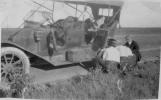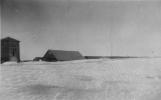2
Prairie FireThe early ranchers braved many hardships and dangers. Mother nature tested their endurance in every season. In dry years prairie fires threatened constantly. Prairie fires destroyed hundreds of acres of grazing land in a single day. Pioneer fire fighters pulled together in times of need.
4
The 1914 Prairie FireThese volunteer fire fighters helped to extinguish a large prairie fire that swept many acres in 1914. Volunteers arrived with horse-drawn stone boats with barrels of water, gunny sacks, and shovels.
5
A pioneer's recollection of the 1914 Prairie FireOctober, 1987
A field near Avonlea, Saskatchewan, Canada
 Credits:
Credits:Mabel Watson
6
Donna: Can you tell us anything about the prairie fires?Mabel: Well, you see, I was back with Reggie for four summers, [19]13, [19]14, [19]15, and [19]16 from spring ‘til fall. And this one year the fire came over where the Monkhouse's were living up there. Reggie took a team and a stone-boat and a barrel of water to go to fight the fire. They used the wet sacks to fight the fire. This team of horses got frightened and came home and they were all burned under the breast and the bodies. I think Reggie came to town and got oil or something to put on them. One had it's tongue partly cut off with the bit because it was tramping on the lines or something. No, I said, most everybody, even at the schools, you had a fireguard.
Donna: What was a fireguard?
Mabel: They plowed furrows around to stop the fire if it came.
Judy: How wide would it be?
Mabel: I don't know... Maybe a half a dozen furrows.
Donna: That would be plow furrows?
Mabel: Yes.
Donna: So, that would be maybe twelve feet wide, about?
Mabel: Yes. But there was quite a few fires in them early days.
8
Not too long before we moved back to the States, Mom and we children went to a beach resort on Long Lake near Regina and stayed a week. The local banker took us in his model T Ford. It was known as Regina Beach. We started about day break and got there about 9 PM, it was a distance of about 100 miles. We did a lot of pushing. Some hills the car couldn't climb unless everybody got out and pushed. And that, plus lots of flat tires and the car overheating, it took time to travel in those days. My bathing suit was just a sweater and a pair of knitted pants. the song of the day was "8 O'Clock Girl" and the local band played it day and night. But the crowning point of the trip was an all day boat ride on the lake.9
A pioneer's reflections of the Dirty ThirtiesOctober, 1987
A farm near Avonlea, Saskatchewan, Canada
 Credits:
Credits:Mabel Watson
10
Ron: Do you remember anything specific about the dirty thirties and how it affected farmers and how it affected yourself?Mabel: Well, you were short of money and short of clothes. I said we didn't starve because we milked cows and raised chickens and pigs. You could sell a little pig for about a dollar a piece then. We ate pigs back in the 30's that were as good as your turkey. Well, they'd maybe be a couple of months old but you couldn't hardly sell them. We cooked them just like a turkey.
Ron: Grandma, I hear people tell stories about eating dandelions and greens like that in the 30's. Is that right?
Mabel: Well, I never did. Father used to eat some greens.
Ron: They'd go out and collect dandelions...
Mabel: No. Pigweed or something. Father used to eat that. Boil it.
Ron: You never got into pigweed.
Mabel: No. We didn't starve but we didn't have all the money or all the clothes. I think Herb bought me a coat for $5 once at McRorie's that had hung in the store for years; it was a tweed coat that had hung in the store for years. The Throwers used to get a few clothes... Mr. Thrower had a sister married to a policeman in Toronto, that had a couple of sons. And they used to send Throwers clothes but they were always too big for their boys. I remember Harold getting pants and coat from Mrs. Thrower that these folks from Toronto would send out.
12
1947 SnowIn this picture, snow is seen level with the eave of the building and the 10 foot high fence designed to prevent snow from building up on the train tracks. Note the height of the snow against the CN water tower (left), and the train (right).
14
1947 SnowIn the winter of 1947, all transportation came to a halt and everyone was isolated for weeks. Food became scarce; animals perished. This condition continued until spring when the ten foot snow banks could be cleared from the railroad and supplies were replenished.




